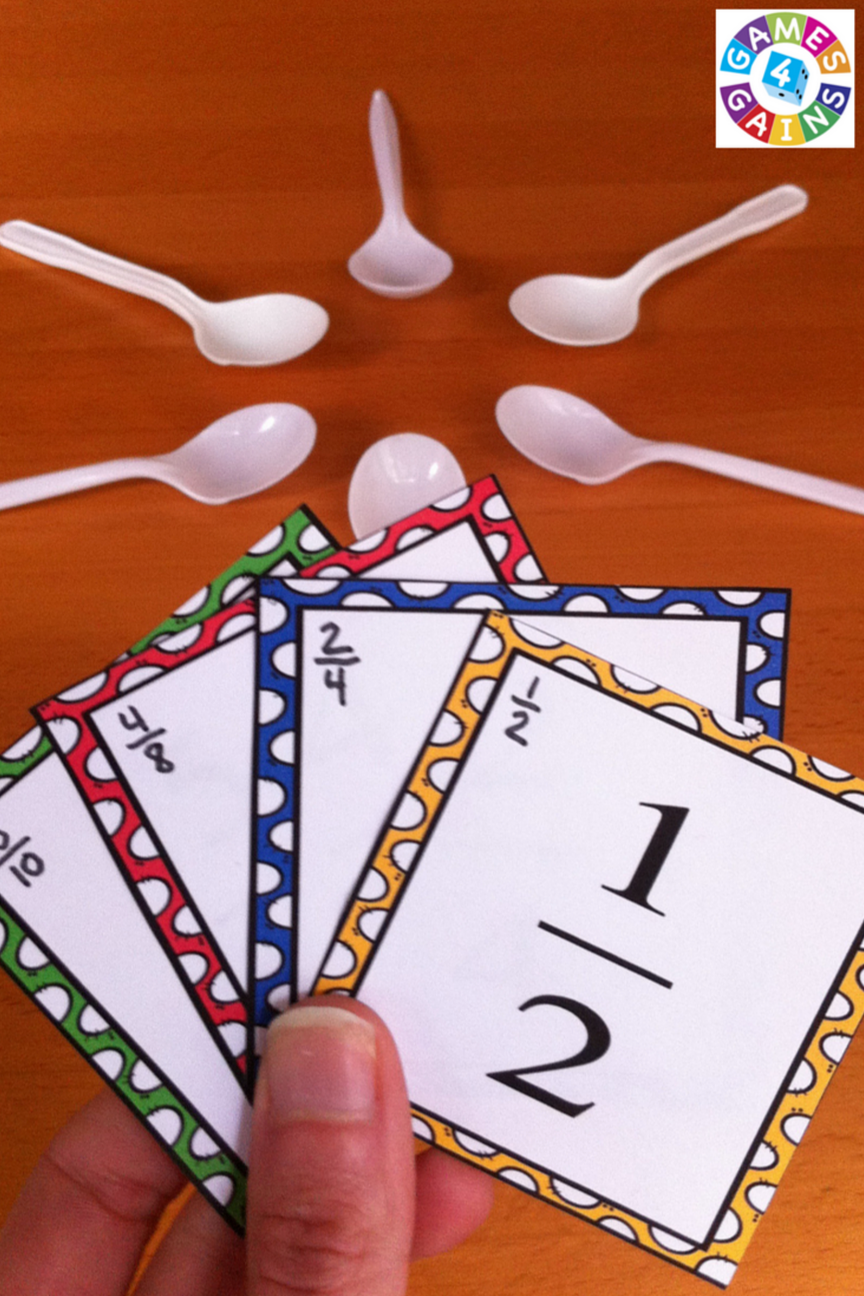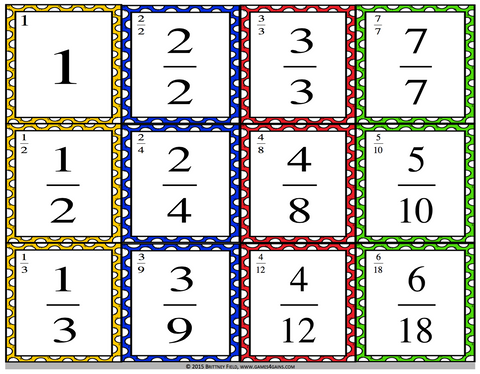Introduction to Equivalent
Fractions: “Show Me″
Materials: 2 sets of fraction strips for each student,
numberline for each student, numberline and fraction strips for teacher to
display on overhead, document camera, projector, or just hold up.
Format: Students working individually or in pairs
Game Play:
The teacher names a fraction and asks students use specific
fraction strips to build that same value on the number line: “Show me ____ made
out of ____ strips.” The teacher continually walks around the group and
confirms with a nod or verbal yes if the fraction is right. If not the teacher
says, “try again.”
Start with making 1/2 out of powers of 2 (4ths, 8ths)
Move to making 1/2 out of other even numbers (6ths, 10ths,
12ths)
Then make other unit fractions out of their multiples (1/3 out
of 9ths, 12ths, and 15ths, 1/5 out of 10ths and 15ths, etc.)
Then make other proper fractions out of their multiples (2/5 out
of 10ths, 2/3 out of 15ths, etc.)
Then make simpler fractions from reducible fractions (10/12 out
of 6ths, 2/4 out of halves, 12/15 out of 5ths, etc.)
Finally, make improper fractions (7/5 out of 15ths, 15/12 out of
4ths, etc)
Extra Support: Encourage students to make the identical fraction
to yours first, and then line up the strips you requested below it until the
lengths are the same.
Extra Challenges: Ask for impossible equivalences, like 1/2 made
out of 3rds, or 10/12 made out of 5ths. Ask students to come up with possible
and impossible challenges.
EQUIVALENT FRACTIONS GAME OF 'SPOONS'

This game for practicing equivalent fractions is a variation on the classic card game "Spoons." If you've ever played "Spoons" before, you know that the game is super fast-paced and lots of fun. I figured that if I could combine the fun and exciting parts of "Spoons" with some equivalent fractions practice, I'd have a center game that my students would be dying to play. And let me tell you, this one does not disappoint!
How to play Equivalent Fractions "Spoons":
Number of players: 3-6 players
Preparing the materials:
1. Print out the Equivalent Fraction cards that was created for this game by CLICKING HERE. Cut out each of the cards.
2. Grab some plastic spoons (or any other object that can be grabbed by the players). You need one fewer than the number of players. For example, if you have 6 players, you'll need 5 spoons.
Object of the game:
To be the last player remaining in the game. Players get closer to being eliminated each time they are left without a spoon, which earns them the next letter in the word S-P-O-O-N. Once a player has earned all 5 letters in the word S-P-O-O-N, he or she is out.
Getting ready to play:
1.Arrange the spoons in a small circle in the center of the table.
2.Shuffle the equivalent fraction game cards and deal four cards face down to each player. The players may look at their own cards, but may not show their cards to anyone else.
3.Choose a dealer for the round. The remaining cards should be placed in a pile facedown beside the dealer.
Playing the game:
1.The dealer takes a card off the top of the pile so that he or she now has five cards in his or her hand. The dealer removes one of the five cards from his or her hand and passes it facedown to the player on his or her left. The dealer then continues to pick up cards from the pile and discard one card at a time to the player on his or her left.
2.The player to the left of the dealer picks up the discarded card from the dealer. Like the dealer, he or she removes one of the five cards from his or her hand and passes it facedown to the person on his or her left. He or she continues to do this as cards continue getting discarded to him or her.
3.This quick picking up and passing of cards continues around the circle. The last player in the circle always places his or her discarded card into a trash pile. These cards are now out of play for the round.
4.Once someone gets four-of-a-kind (four fraction cards that are equivalent makes four-of-a-kind) in his or her hand, he or she grabs a spoon from the center of the table. Once the player with four-of-a-kind takes a spoon, everyone else tries to immediately grab a spoon (even if they do not yet have four-of-a-kind).

5.The player left without a spoon earns a letter in the word S-P-O-O-N.
6.The round is now over and the game begins again. If any players were eliminated during the last round, a spoon must be removed so that there is always one fewer spoon on the table than players.
Equivalent Fractions Musical Plates

Get children up and moving with this fun, kinesthetic fraction activity. Children are given a fraction and dance around to music, trying to find its equivalent. Written and visual representations of fractions are used to assess children’s understanding!
What you need:
- sticky notes
- paper plates
- permanent marker to write fractions
- visual representations of fractions to glue on the plate
- music
What to do:
Give each student a fraction written on a sticky note. Students remember their fraction and stick it on their shirt. Next, lay out the paper plates with fractions written or pasted on them. You should make a variety of equivalent fraction plates for each student and spread them far apart. Then each student will have to really look to find a plate that is equivalent.
Start the music. Students dance and hunt for a fraction that is equivalent to their own. When they find it, they stand on the paper plate. If they don’t find an equivalent fraction before the music stops, they’re out! For each round, students keep hunting for fractions. Once there are no more fractions that are equivalent to their own, they sit out. They found all of their fractions!
This fraction game for kids can be played as a whole group or with small groups to assess learning.
Interactive Online Games















